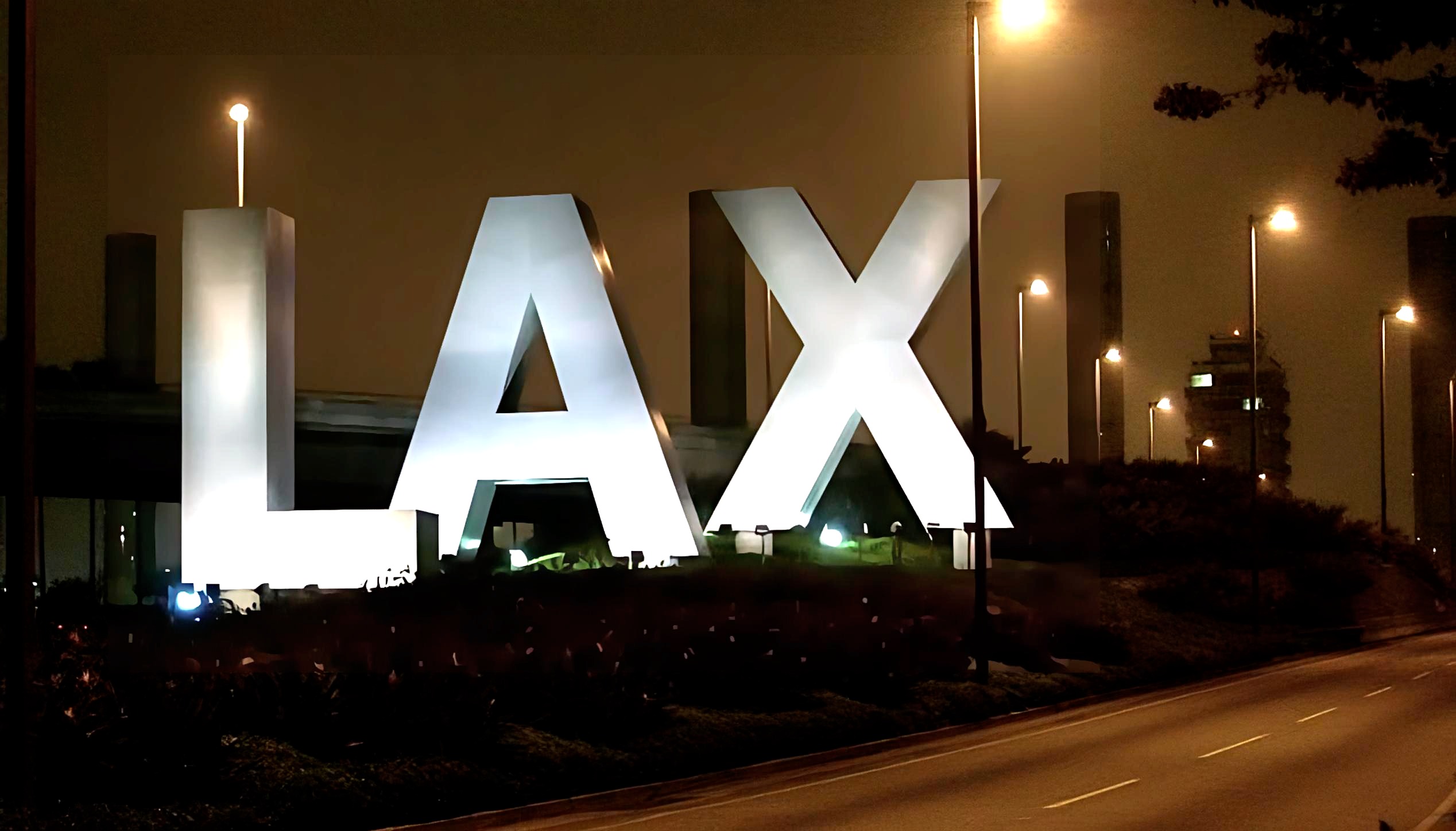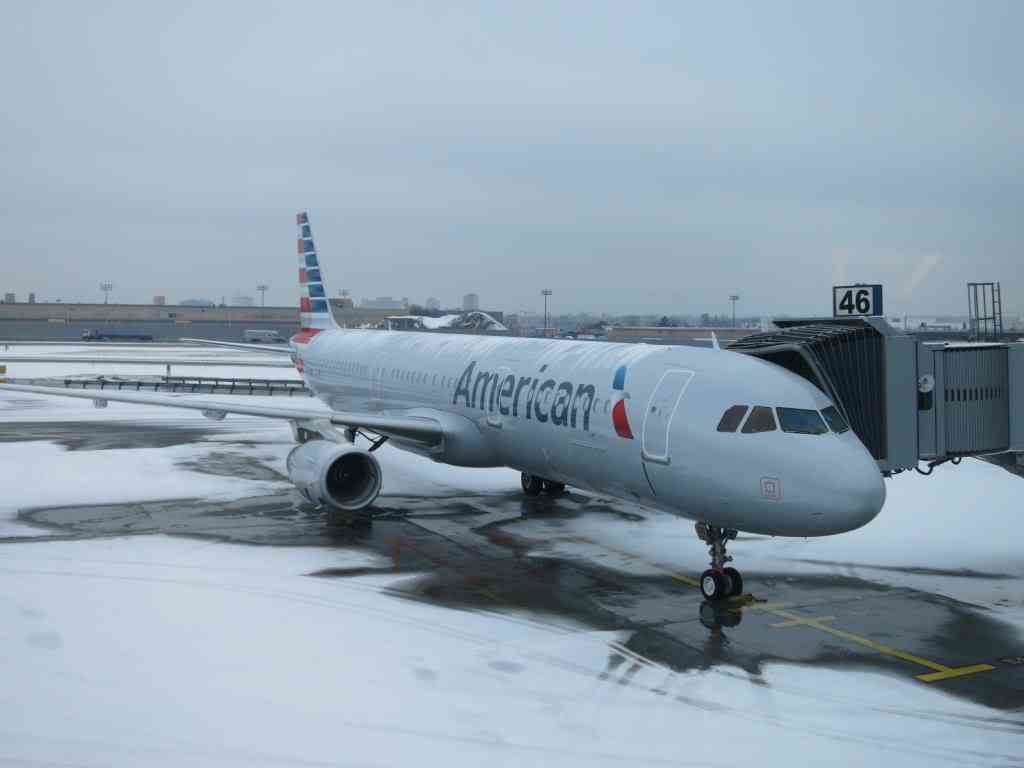An American Airlines Airbus A321 from Los Angeles to Boston was forced into a high-speed rejected takeoff on Sunday night when a German cargo jet that had just arrived from Shanghai crossed its runway by mistake.
Around 10:35 p.m. American flight 2453 accelerated down Runway 25R with 94 passengers and seven crew onboard. At roughly 160 miles per hour, the crew was ordered by air traffic control to cancel takeoff clearance when AeroLogic Boeing 777 freighter entered the active runway without clearance.

The two aircraft got within 5,200 feet of each other. The risk came from the American flight already approaching its decision speed when the freighter crossed ahead of it.
The A321 slowed safely and returned to the apron. After a delay of more than two hours, the flight departed again and landed in Boston before 9 a.m. Monday.
- American was cleared for takeoff, rolling at high speed
- AeroLogic cleared to cross 25L, instructed left on Taxiway Q
- Instead, AeroLogic turned right on Q, crossed 25R without clearance
- ATC: “German Cargo 619, stop … American 2453, cancel takeoff clearance”
“German Cargo 619, stop!” LAX ATC shouted as an AeroLogic 777 crossed runway 25R, 1.3 miles down the runway from an American Airlines flight to Boston. The jet slammed on the brakes at 167 mph — all captured live on the 24/7 Airline Videos cameras. pic.twitter.com/KsPxcQbciH
— AIRLINE VIDEOS (@airlinevideos) September 29, 2025
The FAA is now investigating how the AeroLogic crew wound up on the wrong taxi route, turning right instead of left. While the 5,200 foot separation may sound large, the danger was acute: an A321 accelerating near takeoff speed faced an unexpected obstacle ahead, forcing a rare high-energy stop.
When an airliner accelerates for departure, there’s a critical speed called V1 (the “decision speed”). Below V1, crews are expected to reject the takeoff if something goes wrong. Above V1, they are committed to fly, because stopping on the remaining runway may not be possible.

High speed means high risk. At about 160 miles per hour, the Boston flight was already near V1. Rejecting at that point requires maximum braking, high brake temperatures, and precise control to avoid runway overruns. An unauthorized aircraft on the runway ahead is one of the few reasons ATC would cancel a clearance at this stage, because it’s a critical risk.
AeroLogic is a German cargo airline that’s owned by DHL and Lufthansa.
Update: American Airlines shares,
On Sept. 28, American Airlines flight 2453, with service from Los Angeles (LAX) to Boston (BOS), discontinued its takeoff after the crew observed another aircraft on the runway. The aircraft later re-departed for BOS normally. We thank our crew members for their quick action and our customers for their understanding.


This is one of those moments that really shows just how thin the margin of safety can be in aviation. An A321 already barreling down the runway at 160 mph had to slam on the brakes because a 777 wandered across at the worst possible time. Credit to ATC for making the right call in a split second, but it’s a reminder of how quickly a normal day can turn into something that’s almost unthinkable.
And this isn’t just a one-off mistake. The FAA has been getting hammered lately for being slow to act on runway incursion fixes. Out of two dozen improvements recommended, only a handful have actually been put in place. They’re now rushing to roll out new sensor and alert systems, but it’s years behind where it should be. Pilots are calling for cockpit-based runway alert systems like Honeywell’s SURF-A to become standard, because right now too much is left to human eyes and radio calls. Until the FAA really connects the dots and treats these incidents as part of a pattern instead of isolated events, the system is still running way too close to the edge. Sadly, a whole lot of our best aviation safety standards are written in blood. It shouldn’t have to be that way.
Lucy you got some splain’ to do…
Wow, that was one helluva “pucker factor” for the AA takeoff crew !!
It seems like this was heroic and quick acting by ATC at LAX. Just curioius, why did it take the American plane two hours to get back in the air. Did the stress of the braking necessitate special mechanical attention or a new crew because the crew’s blood pressure was pushed to extremes.
5,200 feet = 1 mile.
@David R. Miller — Nah, 5,280 feet = 1 mile… those extra 80 feet still count.
It happens when you fly enough. I’ve had way more aborted landings though- at least a dozen. Most happen early- as in maybe 1/2 mile from the runway or more, but 2 (exactly) happened less then 100 feet above, which as most readers will know takes way more time to get back up in the air.
Aborted takeoffs- for me at least- have only happened twice. Once on my 5th ever flight leaving DFW, (~1992?) we aborted at around 100mph or so. People were scared.
The other was just at PHL in the last year, about halfway down the runway, and while no where near V1, still was kind of scary, and more frustrating since we had to get maintenance to look at a ‘light’ and took another 2 hours, but that’s obviously better than the alternative of not writing this comment.
@Jon Biedermann — Well said. Better to still have you with us!
Go arounds are a hassle and can be a handful if not properly briefed and executed. A V1 cut is something else. Luckily, I’ve only done it MANY times in the sim. I pray I’m not going to do one for real. But…I am prepared. RTO braking will leave you speechless and sweating when you finally stop. You then call for the fire trucks, if possible collect your thoughts and taxi back to the gate and then head to the restroom…you’ll need it…or the dry cleaner. Many companies will excuse the pilots from the flight.
At 160mph, it is 234.67 feet per second. Rotation speed is around 168mph or slightly higher for the A321 depending on a lot of conditions with the exact speed calculated by computer (from a Google search). The 5200 feet of runway in between the airplanes would take about 22 seconds to travel but would actually take less because the speed was increasing. With braking, the time between the airplanes gets longer. Fortunately the airplane taking off had enough runway to brake to a stop. The ATC said left to the cargo crew and the crew acknowledged left but then turned right. There should have been an immediate reaction between the pilots in it. The ATC controller was calm and level headed which helped. The mechanics must have found no brake or tire (or other systems) damage to release the airplane to fly on such a short delay for such a situation.
“”Google Maps Airport Runways” Atc edition
Turn left, Turn left
I would hate to be on a plane that stopped so quickly. That would be scary.
Talking about scary; I have had two go-around in the last year. The first did not concern me because it was the Seymour Galapagos Ecological Airport (GPS). The windy conditions there cause go arounds all the time.
The second was more worrisome. Flying into SFO, we almost landed, I could see the runway on either side, then suddenly our plane banked steeply up and climbed rapidly. I was joking with the passenger next to me, saying it might be like “look truck”. Once we got into the holding pattern, the pilot came on the speaker and said they did a go around due to “congestion on the runway”. Congestion on the runway should not happen in a major airport like SFO.
Actually, I am hoping that other travelers share similar stories.
That LAX sign isn’t there anymore. Going to need you to make a bizarre-o AI image so we can understand the article. Tks.
At LAX, pilots are trained to avoid a pesky “Bang, Ding, Ow” aircraft collision because it may ruin their afternoon.
@Ken A — Yes, Sum Ting Wong.
(It’s still surprising that nearly everyone survived Asiana 214, except that poor girl who was hit by the fire truck.)
@ John A Warnick RE: Why so long to get back in the air?
It’s all about brake cooling, and possibly a maintenance inspection. After a high-speed rejected takeoff, the brakes are so hot that you couldn’t successfully perform a second rejected takeoff if you went right out again. The brakes need to get below an acceptable temperature. On some planes you have a chart to follow to tell you how long to wait (max speed reached, weight of aircraft, adjust for altitude, outside air temp, and even the length of the taxi out to the runway – and you read the minimum cooling time, which is often over an hour). Other planes have temp sensors directly on the brakes you reference.
Rejected Takeoffs may also require a maintenance log entry (depending on the aircraft, company procedures, speed reached before the reject, etc.) which would require a return to the gate, a maintenance inspection, and a sign-off of the paperwork before departing again. Maintenance personnel also have fans that can be used to cool the brakes.
Crews practice (multiple) rejected takeoffs each and every recurrent simulator training event (every 6-9 months) – and they are practiced from multiple scenarios (most commonly either ATC initiated, or mechanically caused – like from engine failures or engine/apu fires). They are very rare events “in the wild” out on the line, but a pilot will do several hundred of them (at least!) over the course of a career. They certainly get your attention when a rejected takeoff happens for real, and the margins are narrower than other “normal” parts of the operation – but all planes are designed to handle them and all crews trained to perform them.
@ Other Just Saying RE: Go Arounds in SFO
I’ve flown into SFO for decades, and done my share of go arounds there and lots of other places too. The most common reasons for doing one are 1) the weather prevents you from seeing the runway, after descending as low as the approach to the runway allows, 2) you took too long to get the aircraft configured for landing and “stable” i.e. gear down, flaps in landing position, power up, and at your desired speed, and 3) the aircraft you were following took longer to exit the runway than anticipated.
The maneuver can be startling for passengers, but they are often predictable for crews. It’s easy to see the plane you’re following is taking too long to exit (or also in the case of SFO, the aircraft departing on the crossing runway is too slow on their takeoff roll) and you can clearly see that a go around is likely long before you’re told to do one by ATC. When it happens for a conflicting aircraft either on or crossing your runway, you are likely still at 400′-500′ and maybe 1-2 miles away laterally.
There’s lots to do when it happens – climb out, reconfigure the aircraft, coordinate the new routing with ATC (often different than the default missed approach route in the “box”), etc. Telling the passengers what happened (and why) is left as the last step – and explaining the subtleties of all of the reasons we’re still airborne is difficult. For example, in SFO, when two planes are landing side-by-side, one is actually slightly behind the other – instructed to maintain “visual reference” from the other in front. If the trailing plane drifts in front of the first one a go-around is sometimes required.
All of that is too complicated to adequately explain on a PA to the passengers, so a simple “We went around due to congestion on the runway” is an easy, condensed exaggeration of reality. And, if we go around because we were late in getting the plane stable – don’t expect a confession over the PA. Any pilot at any airline is going to offer another invented reason instead.
Bottom line – even though it’s startling in the back of the plane, it’s almost always easy to predict and prepare for one from the front.
There were three fatalities on Asiana 214. From Wikipedia: Wang Linjia and Ye Mengyuan, both Chinese nationals, were found dead outside the aircraft soon after the crash after having been ejected from the plane during the crash. Neither victim was wearing a seatbelt. Experts concluded Wang and Ye likely would have survived the plane crash had they been wearing their seatbelts. Ye’s body was run over but a later investigation concluded she was already dead prior to that. Liu Yipeng, died of her injuries at San Francisco General Hospital six days after the accident. Liu had been wearing her seatbelt while seated in 42A, which is on the last row of passenger seats on the left side of the aircraft, immediately ahead of door 4L. During the crash, the back of Liu’s seat rotated back and against the floor, leaving her exposed. Her injuries were likely the result of having been struck by door 4L, which separated during the airplane’s final impact.
@Pilot Paul. Thank you for your long explanation. I will keep it in my mind for the future.
Commenting on your statement “When it happens for a conflicting aircraft either on or crossing your runway, you are likely still at 400′-500′ and maybe 1-2 miles away laterally.”
I understand that go arounds are good for the most part and a sign of a safe pilot. However, this was unusual, because we were so close to the ground and almost on the runway. Way closer in my opinion that “400′-500′ and maybe 1-2 miles away laterally.” In fact, I was getting ready to turn on my cell phone.
My guess is that pilot was about to land and then being a good pilot, visually saw something on the runway he did not like. Maybe as you said a “conflicting aircraft” or maybe as I joked “OMG, there is a truck on the runway”. You are right, I did not see what it was, since there was no forward camera. And the pilot won’t tell. But it was jarring, because we were so so close to the ground.
@jns. Exactly. Smithsonian’s Air Disasters “Terror in San Francisco” (Season 9 Episode 2) analyzes the 2013 Asiana 214 crash. It is an interest watch.
@ Other Just Saying RE: Low Go Arounds
Obviously, it’s impossible to say what happened to you on your flight – and of course I’m only talking about what we see the majority of the time.
Here’s how it normally plays out: Arriving aircraft are usually spaced about three miles apart, which also puts you 1000′ higher than the plane you are following (as you both descend to the runway). Besides seeing these altitudes and distances displayed on the screens, we like seeing things like the tire smoke from the preceding aircraft (their touchdown) right around when we’re just inside 1000′ above the runway (and they exit by the time we hit 500′). That means the spacing was ideal.
However, sometimes ATC doesn’t properly plan with a fast plane following a slow one, or we pilots don’t adhere tightly to our assigned speeds (“Aircraft [xxx] maintain 170 knots until a five mile final”] and this gap decreases significantly. If it becomes obvious that it’s too tight – we get sent around pretty early, like at 500′. At that point, we’ve closed in on the plane in front of us, but they are still a few miles ahead.
There are other times we expect the spacing to work – based on the above-mentioned numbers and a planned exit point of the preceding aircraft – and then they miss the exit and have to go to the next one. ATC might wait to send us around to see if they will get off before we get over the runway, and when they don’t – around we go, even from a low altitude. It’s not at all unsafe. The preceding aircraft may only be one mile down the runway (or possibly more). But if they are not completely clear, the runway isn’t ours to use yet.
Finally, if it makes you feel any better – when we practice autolands (VERY low visibility landings, anywhere from 1/4 mile visibility down to 500′ or less) we regularly do the go-arounds from 50′. That’s literally “over the numbers” as in, over the runway itself, right at the arrival end. Depending on the plane, there is even the chance that we may experience a brief touchdown on the runway, since the plane cannot immediately go from a 900-1000′ foot per minute descent into a climb. Momentum may result in the mains contacting the runway. But it’s normal!
Any disruption from the “takeoff – climb – smooth cruise – descent – land” routine can seem discomforting to the passengers – but when you notice something different happens, 99.99% of the time, we are doing something we regularly and routinely train for. I do wish we could let you know what we are doing sooner so you don’t have to sit there, in the back, experiencing any anxiety about what’s happening – but obviously flying the plane comes first. Most pilots will eventually tell you what happened without getting too much into the jargon if we can.
@Gary
Just wondering. Why did you say AA plane but Boeing 777? The 777 was reported as DHL.
Pity, just a little bit away in Hollywood, the plane would have shifted gears, pulled the yoke all the way back (requiring a switch to a 737 in the movie), and just barely missed the 777. Or, the breaking planevwould have come to a stop 1mm from the 777.
Ground control should not be rushing the aircraft to cross. That might be a factor in the cargo plane making the wrong turn.